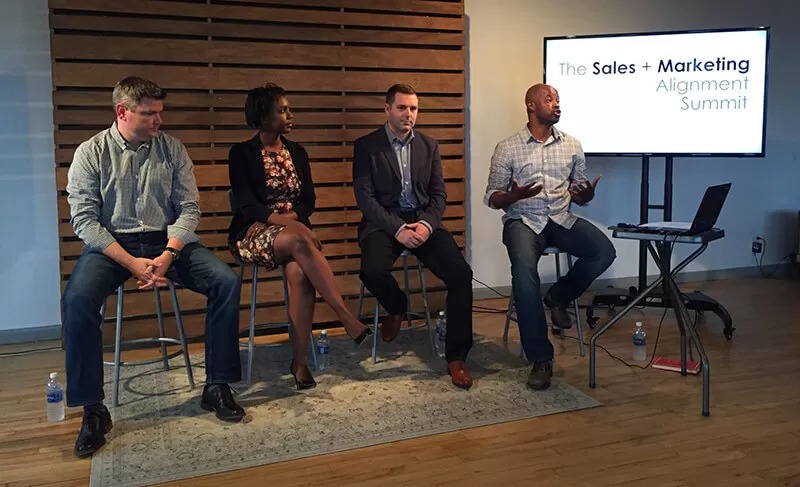
Jeff Davis Creating Togetherness. Bridge the Divide Between Sales & Marketing
Jeff has worked in sales and marketing for over 15 years (interestingly after beginning his career as a NASA engineer! The B2B sales world is blessed that he is truly passionate about sales and marketing alignment.
Misalignment between sales and marketing costs B2B companies 10% of revenue or more per year!
How do you bridge this divide? and transform your revenue engine?
It was a pleasure to speak with Jeff Davis about the challenges between the B2B Sales & Marketing functions. Jeff is an expert in this area and has some great tips and solutions to help align everyone involved.
Watch or listen to the full podcast video here, or enjoy the transcript below.
Steven: I noticed you actually started your career literally as a rocket scientist at NASA. I’m really pleased, this is the first rocket scientist I’ve had on the show! [laughter] How did you get from there into sales, and then into marketing and so forth?
Jeff: It’s interesting that you bring it up, I don’t think I’ve ever had anybody ask me about my time at NASA, and I feel like I inadvertently just don’t talk about it. My education started as an engineer, so I wanted to be, at the time, an engineer at NASA, I had a huge interest in space, and I still do to this day. But in an ironic turn of events, I was talking to some of the consultants that we were working with on a major project, in my senior year of like what do I do with the rest of my life – which is funny, because I think that you still continue to ask those same questions as you become 20, 30, 40, 50, 60 – and one of the feedbacks I got was “You should go into sales or consulting,” and I was like “Wait a second, that’s not going to happen! I’d just spent a good portion of my life trying to get this degree!” and it really influenced the trajectory of my career, and is one of the reasons that I tried out sales, technical sales, right after college, and said, “Worst case scenario, if this doesn’t work and I really suck at it [laughs], I can just go back to engineering, because I have a degree in it.” But I think it has informed the way I think about things in a very strategic way, and I think that’s what has made me successful in sales and marketing.
Steven: So you’re levering off your engineering mindset and everything, to solve these sales and marketing problems.
Jeff: I think so, yeah. I think the process mindset and the methodology of… Anybody [who] has ever interacted with or knows engineers, beyond being very cold people, which ironically I am not, [knows] we think in methodologies.
Steven: Yeah, absolutely. Jeff, you host The Alignment Podcast, and I know you’ve got a big focus on the challenge of sales and marketing teams working well together in B2B. What are some of the issues in this area?
Jeff: There’s a lot, but there’s also an amazing amount of opportunity. I think for me, one of the reasons that I started my work, and why this conversation is bubbling to the top, is that the buyer is demanding that we align our teams and align our forces and align how we come to market. Digital transformation is probably the igniter of this. The modern buyer has access to so much information, they are socially connected, and they can easily reach out to people to get their opinions, and so showing up and talking about features and benefits just is not going to do it anymore. I think one of the things that we also don’t talk about as much in a conversation is that our traditional B2C experiences outside of work are influencing our expectations in the B2B context. So while you may say and think that you’re a B2B company and that you sell in a B2B way, you’re selling to humans, and humans have had interactions with B2C companies and products and services, and they’re expecting the same in a B2B side of the business.
Steven: Okay, so there’s a big driver from the customer. […] It seems that there some challenge between the two functions, [sales and marketing]. What are some of the issues or some of the causes of the challenge there?
Jeff: I always liken it to sales and marketing running a three-legged race at like the family reunion: we are all trying to get to the same goal line, but approaching it in, a lot of times, misaligned ways, and really not even looking at each other, to say, “Which direction do we go?” That’s why it’s more challenging sometimes than it needs to be, and there’s so much frustration and pain, because we really are, at the end of the day, trying to connect with buyers in a meaningful way and convert them to customers, which converts into revenue.
I think that when you look at the historical contexts of sales and marketing, for many organisations, for most organisations, there is still this fundamental silo between the two of them that is no longer serving a purpose. I’ve interacted with clients, or I’ve been a keynote at conferences and talked to folks afterwards: even with the leaders that get it and that want to align with their counterpart, I hear this “I’ve been in marketing all my life. I want to work with sales, but I have no idea what they need,” or “I’m a sales guy, I’ve been a sales guy all my life. I’m a sales leader now. I don’t have the first idea of how to reach out to my marketing counterpart or colleague. What do we do?”
So I think that we have to recognise that it’s not that… I always say that sales and marketing are not fighting with each other, there’s no sales and marketing war, I don’t fundamentally believe that. I think what is happening, what I truly believe, is that there’s a lack of empathy, and people just don’t know what it means to align between sales and marketing. That is one of the reasons that I’ve started my work: because we understand the sales side of the business, we understand the marketing side of the business, but there’s this fuzzy, grey area, which is that sales and marketing interface, that we don’t know a lot about, and we just don’t think about it, but that’s where we’re having the challenge.
Steven: […] What’s the impact of that, if that’s not working, if that alignment is not there?
Jeff: Many things come out of that, and there’s many ways to identify it as well. One example that I’d love to share with you is I was actually in a meeting as a marketing leader, with sales leaders as well, and so I was one of the very few people in the meeting that had been on both sides of the fence, and one of the marketing leaders got into it with the sales leader, they were talking back and forth, and the conversation got a little heated… At some point, I said, “Guys, stop. Do you realise that you literally are saying the exact same thing in a different way?” and the room stopped, and I was like “Let me help you understand that.”
It seems really simple, but you have to be really clear about messaging. As a marketing leader, what I learned really early on is I talked to my marketing colleagues in a different way than I talked to salespeople. It sounds really like it’s not a big deal and “Oh, yeah, obviously,” but there’s just certain words that salespeople don’t use. They don’t use “strategic alignment of resources”, salespeople don’t say that, or “We really want to take a holistic viewpoint on our approach to the market,” salespeople don’t talk like that. Do they say the same things? Absolutely. So when you communicate with them, if want to connect with them, talk their language. It’s the same thing that I say about talking to customers: don’t talk in your speak; talk in their speak.
So a way to determine whether or not you have an alignment issue is that you stereotypically are complaining about the quality of leads, and a lot of companies have identified this. “Oh, these leads from marketing are terrible, none of them convert,” and then marketing is complaining about the same things: “We sends you all these leads, but no one follows up on them…” that is a clear indicator that you have a misalignment issue.
Another one is obviously continuing to miss quota time and time again. So this is not just a few people are not making quota; this is your team as a whole continuing to miss quota – there’s something there that is probably an issue about misalignment. The third one, that is very obvious but people don’t think about, is just an either combative or dysfunctional relationship between sales and marketing. Stereotypically I see it at the leadership level, where they don’t talk, they don’t have a relationship, or they just talk poorly about the counterpart or colleague in front of their constituents, which is a red flag for me. If you’re talking poorly about your marketing colleague to your salespeople, it is an absolute no-no for me, even if you don’t like them. [laughs]
Steven: […]
Jeff: Another thing to think about, that influences that relationship, is that we’ve got to get out of the mindset of bringing new people into the organisation and telling the same story. I was talking to a colleague in training, so we were kind of talking about how does training impact alignment and that sort of thing, and he brought up the point of you literally have people bringing new people into the organisation, on the sales side of the business or vice versa, and saying, “Oh, don’t worry about working with sales, they’re pretty much useless. Just worry about what we’re doing over here.” If we continue to tell those stories, the relationship is never going to change.
Steven: […] What are the suggestions to make this better, to improve this situation?
Jeff: As I was doing my work, whether it would be speaking or coaching with companies, and stereotypically I’m working with midsized companies, because I think they struggle a lot with this, and the impact to them is many times a lot… it hurts more than an enterprise company. I think there’s opportunities across the spectrum, but when you’re a midsized company, and if 10% of your business is essentially impacted by misalignment, that’s a very different conversation than somebody that’s a multibillion-dollar business.
In saying that, I realised that there is a lot of stuff to do, and it is very overwhelming, and I think for a lot of companies, they just say, “We’re not going to do this alignment thing, because there’s too many moving parts,” and you can get to a point where you’re asking people to do so much that they just go into inaction.
So one of the things I pushed myself and challenged myself to do was how do we create, and I continue to do this in my work, how do we create clarity for sales and marketing leaders to be able to strategically think about how they move forward in a way that is transformative but not disruptive? Because asking people to do disruptive things in this space, I would argue, is a little bit too much and will lead to inaction. So I created what I call the three pillars of alignment strategy, so it was my way to distil all the noise, all the things that I’ve heard from analysts and research and academia and I had gone through in my personal career.

Steven: Jeff, before you get into that, can you just explain what you mean by transformative and disruptive? Because they’re sort of similar words, so I just want to make sure I understand where you’re coming from.
Jeff: Sure. For me, disruptive is when you say, “Throw away everything that you know, and we’re going to start from a blank slate.” I don’t think that sales and marketing are fundamentally broken, I don’t think that we need to build a whole new thing. I think that we need to make it more relevant, and I think that we have to transform the way we do things. So when I say transformation, it’s about meeting people where they are, and saying, “There’s a better way to do this. Let me give you a lens of what good looks like and create a vision with you, and then help facilitate you getting there.” Because what I’ve found, just in reading and interacting with people, is when you say disrupt something, people feel like you’re throwing away everything that they did and that everything is wrong, and that for me is not the right approach to alignment. For me, it’s really about talking about “Oh my god, we could do this so much better! We could be more effective, we could be more efficient, if we just learn how to transform the way we look at things, transform the way we go about it, and transform our relationship between sales and marketing.” So I don’t like the language of disrupt, and that’s just how I see the world.
Steven: I agree. And they’ve got to keep the business going too, right? It’s hard enough to get the attention of sales and marketing teams at the moment, they’re very pressed for time.
Jeff: Yeah. And let’s be realistic: if I’m the head of sales, and you come into my business and tell me you’re going to disrupt the way we do things… I’ve still got to make quota. I’m not trying to hear you disrupt and turn off all my sales reps and confuse them. Now, we can make incremental changes and growth, that’s a very different value proposition. But when hen you tell me you’re shutting down the machine? No. [laughs] Not going to happen. I’m not trying to shut down the machine; I’m trying to make the machine more efficient and more effective.

So the framework, as I said before, was a way for me to distil all the things that sales and marketing leaders needed to do. It consists of three different pillars, I call them the three pillars of alignment strategy, and you can find more on my website about it at meetjeffdavis.com, I have a blog post that we can put in the show notes if you’re interested, and that kind of walks people through it.
The first one is data. Most B2B companies don’t really have a hold of their data and don’t really understand how to leverage data. We are sitting on a goldmine of customer interactions and just data about our customers that most people are not leveraging. And if they are looking at reports, it’s done in a very data-focused way, they’re just looking at data. But what we need to do is not be just data-focused; we need to be insights-driven. Data really doesn’t mean anything, until you turn it into insights that inform how I can change my business.
So the first thing that you as a company have to agree on is that we’re going to figure out how to leverage our data and harness our data in a way to tell us what’s going on in our business, and you’ve got to do that eventually where sales and marketing have a single source of truth. I’ve been in meetings where the salesperson shows up to the meeting and the marketing person shows up to the meeting and they’re talking about what they need to do, and they are operating from two completely different sets of data, and the data don’t agree. So until we can get on the same page with the data, you can’t move the business forward, because your worldview is completely different.
…We leave the interview there for now. Follow the link to listen to the full 36 minute podcast.
Listen to the complete Podcast with Jeff Davis.
Leave me your comments!



